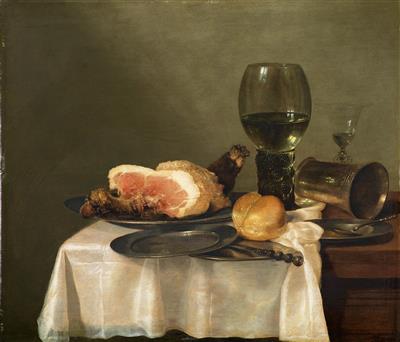Willem Claesz. Heda

(Haarlem 1594–1680/82)
A banquet still life with ham, a rummer, a toppled silver goblet, a roll, and three pewter or silver plates,
signed and dated at lower right, on the front of the table: Heda 1647,
oil on panel, 58 x 67 cm, framed
Provenance:
Barthold Willem Floris van Riemsdijk (1850–1942), Amsterdam (according to a label on the reverse);
sale Christie’s, Amsterdam, 10 November 1992, lot 60;
European Private Collection
E. Gemar-Koeltzsch writes about Heda and his paintings (in: Holländische Stilllebenmaler im 17. Jahrhundert, Lingen, 1995, p. 418): ‘Together with Pieter Claesz, Willem Claesz. Heda can be considered the most important exponent of the so-called “monochromen banketjes”. For his compositions, the painter mostly limited himself to a small number of objects. A rummer or berkemeyer glass, a silver-plated tazza that is mostly shown toppled over, a pewter plate, a so-called Jan Steen jug, and a knife featuring a richly decorated handle are considered most typical of this artist. After 1645, several elaborately decorated objects, such as Venetian glassware, flutes or measuring glasses, a lidded golden goblet, a chiselled silver beaker, and silver salt cellars of various shapes were added to this repertoire. Heda complemented such tableware with peeled lemons, ham, a pie, crayfish, or oysters. His pictures also include the obligatory roll, as well as olives or nuts. The colour scheme of his paintings is primarily dominated by olive and grey hues. […] Whereas in the paintings of Pieter Claesz the objects are arranged diagonally across a picture’s space and assigned to one or two principal directions, the objects in Heda’s paintings occupy spatial compartments on the table and, by means of light reflections, produce an atmospheric glow that is meant to connect and surround objects and space. […] The adumbration of spatial or aerial volumes by the allocation or adjustment of certain objects on the table is a highly individual feature of Heda’s painting style.’
Delicately nuanced colour combinations of soft grey and silvery tones that mostly appear against greyish green backgrounds are characteristic of Heda’s still lives. Reflections, such as those of a white napkin on a metal dish, are precisely observed, and his compositions in general, such as the present work, are carefully balanced.
21.04.2015 - 18:00
- Dosažená cena: **
-
EUR 198.200,-
- Odhadní cena:
-
EUR 100.000,- do EUR 150.000,-
Willem Claesz. Heda
(Haarlem 1594–1680/82)
A banquet still life with ham, a rummer, a toppled silver goblet, a roll, and three pewter or silver plates,
signed and dated at lower right, on the front of the table: Heda 1647,
oil on panel, 58 x 67 cm, framed
Provenance:
Barthold Willem Floris van Riemsdijk (1850–1942), Amsterdam (according to a label on the reverse);
sale Christie’s, Amsterdam, 10 November 1992, lot 60;
European Private Collection
E. Gemar-Koeltzsch writes about Heda and his paintings (in: Holländische Stilllebenmaler im 17. Jahrhundert, Lingen, 1995, p. 418): ‘Together with Pieter Claesz, Willem Claesz. Heda can be considered the most important exponent of the so-called “monochromen banketjes”. For his compositions, the painter mostly limited himself to a small number of objects. A rummer or berkemeyer glass, a silver-plated tazza that is mostly shown toppled over, a pewter plate, a so-called Jan Steen jug, and a knife featuring a richly decorated handle are considered most typical of this artist. After 1645, several elaborately decorated objects, such as Venetian glassware, flutes or measuring glasses, a lidded golden goblet, a chiselled silver beaker, and silver salt cellars of various shapes were added to this repertoire. Heda complemented such tableware with peeled lemons, ham, a pie, crayfish, or oysters. His pictures also include the obligatory roll, as well as olives or nuts. The colour scheme of his paintings is primarily dominated by olive and grey hues. […] Whereas in the paintings of Pieter Claesz the objects are arranged diagonally across a picture’s space and assigned to one or two principal directions, the objects in Heda’s paintings occupy spatial compartments on the table and, by means of light reflections, produce an atmospheric glow that is meant to connect and surround objects and space. […] The adumbration of spatial or aerial volumes by the allocation or adjustment of certain objects on the table is a highly individual feature of Heda’s painting style.’
Delicately nuanced colour combinations of soft grey and silvery tones that mostly appear against greyish green backgrounds are characteristic of Heda’s still lives. Reflections, such as those of a white napkin on a metal dish, are precisely observed, and his compositions in general, such as the present work, are carefully balanced.
|
Horká linka kupujících
Po-Pá: 10.00 - 17.00
old.masters@dorotheum.at +43 1 515 60 403 |
| Aukce: | Obrazy starých mistrů |
| Typ aukce: | Salónní aukce |
| Datum: | 21.04.2015 - 18:00 |
| Místo konání aukce: | Wien | Palais Dorotheum |
| Prohlídka: | 11.04. - 21.04.2015 |
** Kupní cena vč. poplatku kupujícího a DPH
Není již možné podávat příkazy ke koupi přes internet. Aukce se právě připravuje resp. byla již uskutečněna.
